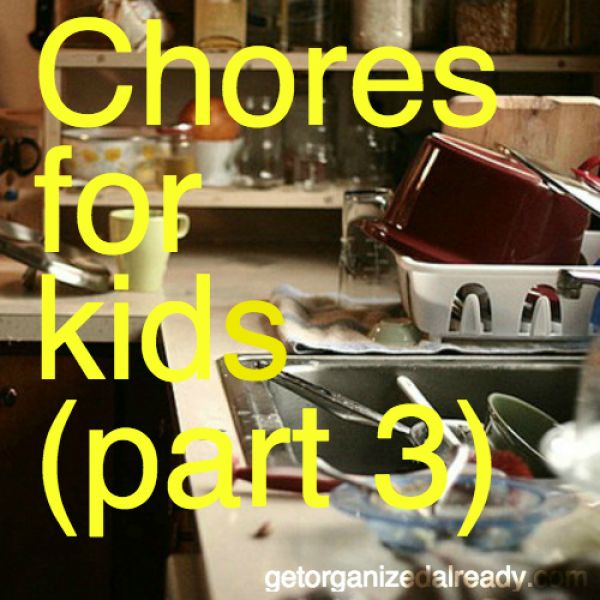Chores for kids pt. 3: The subtle arts of persuasion and bribery

Looking around the kitchen I see a big, fat mess! And it’s my turn to clean it up tonight. I don’t even know where to start. There’s a sink full of dirty dishes, splattered oil all over the stove, crumbs on the floor. The dishwasher hasn’t been emptied because of a schedule mix-up.
Oh, it’s dismal all right!
In general, I am a pretty healthy person. But man, when I have a kitchen-full-of-mess staring me in the face I am all about a cocktail or a few cookies to get me through it.
Do you like a treat when you are doing something taxing? Or a reward after you do it?
Keep this in mind when you are assigning chores for kids, specifically older kids. Sometimes a treat while you work is as rewarding as a treat after the job is done. One of the life skills I admire in other people is the ability to make a sucky job enjoyable. Admittedly, I’m still working on developing that skill myself and have been thinking about how to nurture it in my children.
On one hand, I DO NOT ADVOCATE EXCESS BRIBING because life doesn’t promise you M&Ms and our goal is to get our children ready for real life. On the other hand, one of the most effective methods of chore persuasion I have found sounds like this:
Yes, you can have dessert. After you have cleared the table.
and this
Yes, we can go to the park. After you put away all of your things that are on the floor.
Yes, you can watch TV while you fold your clothes.
and even this when they are older (and can understand consequences abstractly)
We cannot go for yogurt today because you didn’t finish your chores before we left the house. (assuming that expectation was made clear so the announcement of their failure isn’t a surprise)
Let’s talk some practical ways to motivate kids. I’m anxious to learn from you in the comments section, too. Please! I need ideas just as much as anyone.
Chore chart: the old standby
Chore charts work for self-motivated people (like professional organizers).
A very simple chart (attached) can work for young children for things like:
Stay in my own bed all night.
Brush teeth.
A more advanced chart may include the pay rate for each chore. (The attached 2-week chart is pictured here.) Xs are on days when the chore doesn’t need to be done. Stickers go on the days the chore was completed.
Chore board

Chore boards are more free-flowing than charts for kids who aren’t as type A.
Create a board (or just a blank space) that has an area for each kid. Chores are on post-it sized paper. Kids get to pick their chores for the 2-month period (or however long your family decides to go between chore rotation) and put the post-its in their own area.
OR
Use an erasable surface and write 1-3 chores for kids on it each day. Even if there isn’t a chore to do, write something new there for the first week or so until everyone is in the habit of checking the board.
Fill a container
Use a (small) physical container and gems/rocks/beans. Each deed earns a rock or gem in the container. Ten rocks/full container = reward.
Draw a container (a la fund raising) and color in segments when chores are completed. When the container is colored in, it’s reward time.
For all systems:
Phase 1– Give them the sticker, the money, something right at the time of service–praise and celebration.
Phase 2– They mark off their own progress. Praise and celebration come upon reaching a goal, or at the end of the week.
Phase 3– No big whoop. You did your chores. Of course you did!
Some kids will be motivated to do the work to get the reward. And some, like me, will appreciate the treat while they are working. Of course, the most important aspect of the system is that you try to be consistent (like we talked about last week).
Some non-monetary treats to be enjoyed while working:
- Play their favorite music LOUD during family chore time.
- Hang out with them while they do their job. This is one tricky because it isn’t good to do the job for them, and that is tempting if you are just sitting, hanging out. But, some alone time with you may create a positive association with doing their chore.
- A lollipop or gum while they vacuum or water plants, etc.
Pro tip: Avoid overwhelm by setting a timer so kids can see the end in sight.
Next week: what to do when even a fancy chore chart and watermelon Hubba Bubba don’t motivate your little angel.